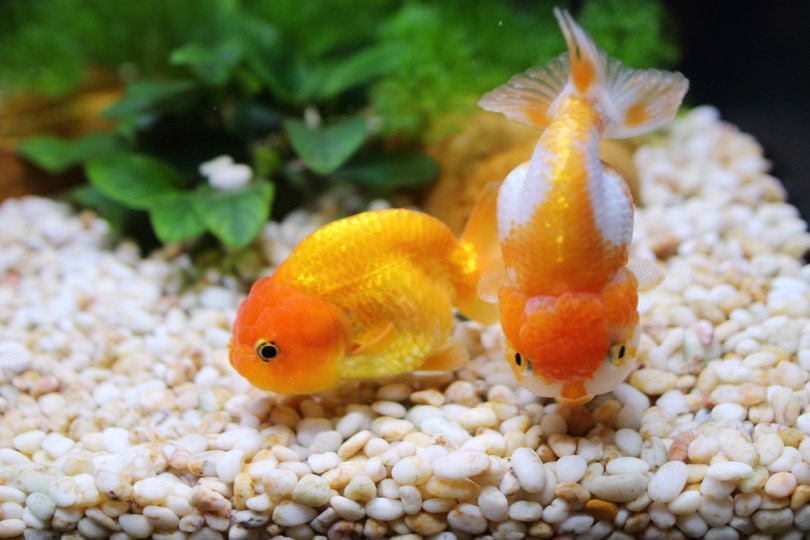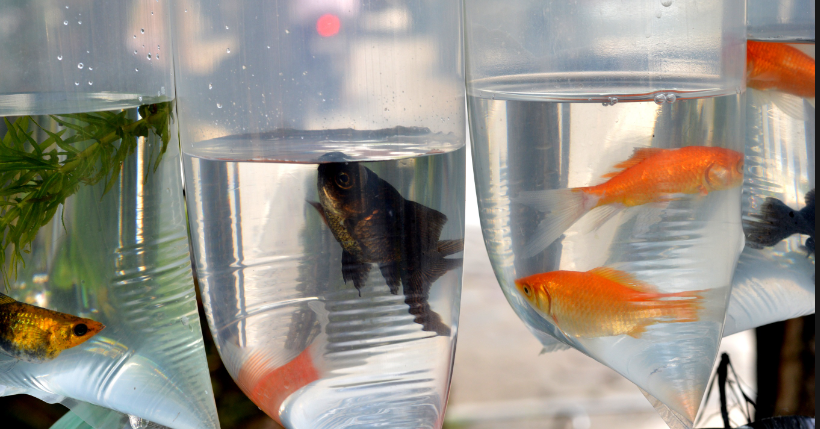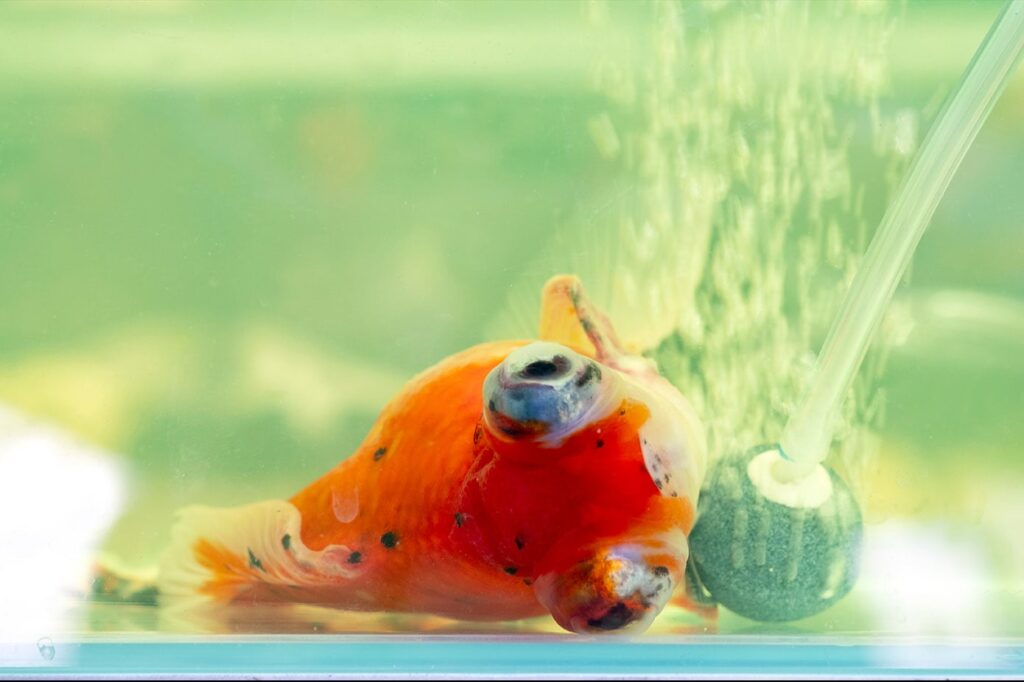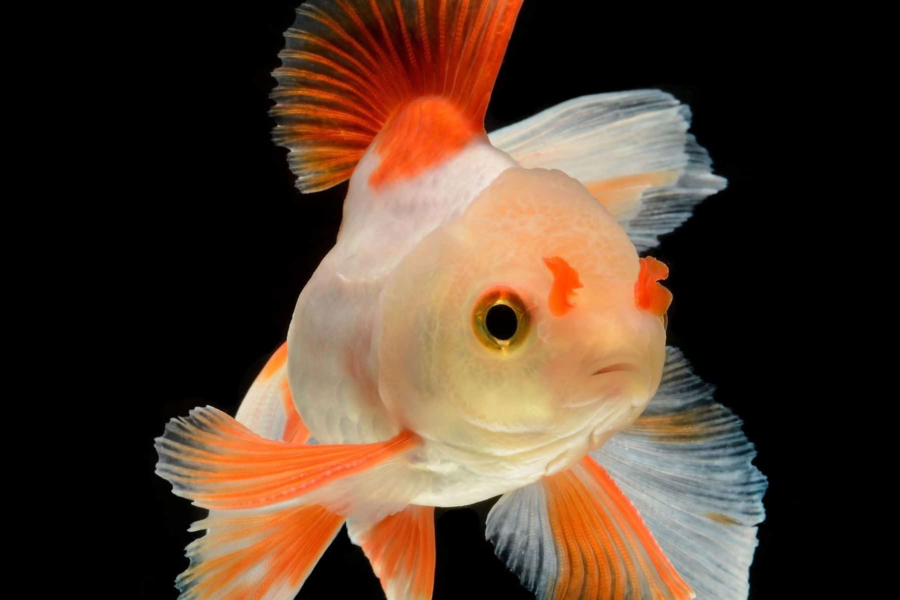
Ladies, gents, and goldfish aficionados, buckle up for a thrilling deep-dive into the aquatic world of goldfish stress. Yes, you read right—those flamboyant, fin-flapping floaters get just as stressed as you during a rush hour commute.
In our guide, you’ll master all there is to know about goldfish psychology—detecting stress, understanding factors causing it, and crafting goldfish-friendly environments. We’ve also covered vital topics like feeding for stress reduction, regular water changes, and even handling and transportation tips. So, grab a cuppa, stay tuned and let’s ensure our goldfish live stress-free, happy lives!
Understanding Goldfish Stress

Ah, the life of a goldfish. Swimming without a care in the world, right? Well, not quite. Despite their carefree image, our scaly little friends can get stressed out too!
Factors that Cause Stress in Goldfish
We might think, “Hey, they’re just swimming in a bowl. They’re stress-free!” But there’s a lot more to it. Goldfish can be disturbed by simple things we humans wouldn’t think twice about. Loud noise, brightly lit environments, or sudden temperature changes – these can all turn your goldfish’s world topsy-turvy.
Signs of Stress in Goldfish
Before you go feeling guilty about that loud party last weekend, don’t worry. Goldfish will let you know if they’re stressed. Watch out for unusual behaviors. Are they eating less? Swimming weirdly? Or maybe they’re hiding more often? It could be a sign of stress.
So, now that we’ve understood about goldfish stress, let’s plunge into the specifics. What can we do to ensure a stress-free environment for them? Brighten those little fishy moods? Hop on the next section as we discuss about a goldfish-friendly environment.
Creating a Goldfish-friendly Environment

Picture this scenario: You’re a goldfish – a veritable small fry in a big pond. Imagine swimming laps in a space the size of your living room. Got it pictured? Great! That’s the kind of room your aquatic friend needs.
The Right Tank Size and Shape for Goldfish
Goldfish don’t like being cooped up in small spaces (who does?). With space to move, they can live healthier, happier lives. Most experts agree that a 20-gallon tank is perfect for a single goldfish, and for every additional goldfish, add another 10 gallons. The shape matters too. Opt for a rectangular tank for a “school with a view” and plenty of surface area for oxygen exchange.
Ready for the next leap? Let’s dive into establishing prime water conditions for our glimmering companions.
Ideal Water Conditions for Goldfish
Goldfish are not saltwater but freshwater fish that appreciate stable water conditions. Aim for a pH level of around 7.2 to 7.8. Keep the water temperature consistent, between 65 to 75 degrees Fahrenheit. Luckily, these divas are quite forgiving with small fluctuations. But remember, sudden extreme changes can cause your fishy pals anxiety. We don’t want that, do we?
Ever wondered if goldfish like mood lighting? Well, your curiosities are about to be satisfied. Let’s set the scene for your gilled sidekicks.
Importance of Hiding Spots and Plants
Believe it or not, goldfish love playing hide and seek. Tanks with plenty of hiding spots can really help take those stress levels down. So, consider adding rocks, caves, or even a castle to your tank. No kidding, they’ll love it!
As for plants, they’re not just tank decor. They help create a natural living environment and, dare I say it, a bit of salad bar for some goldfish. Keeping live plants in the tank not only adds to their food variety but also provides them areas to rest and play.
Believe it or not, diet also plays a role in stress management. Are you ready for a culinary journey from the perspective of a goldfish? Let’s go!
Feeding for Stress Reduction

Now here’s the deal, just as you love pizza but also need your fresh fruits and veggies, goldfish also need variety in their diet for good health and stress reduction. Let’s dive deep into the world of aquatic food pyramid.
Choosing the Right Food for Goldfish
Yummy for goldfish comes in many forms! In addition to flakes or pellets, a good mix of vegetable-based foods, and occasional treats of live or frozen options is perfect. Foods rich in Vitamins A, C, and E especially aid in reducing stress.
The Effects of Overfeeding
Ever just eaten so much at Thanksgiving that you’re rendered immobile? It’s not a pleasant feeling, right? Well, overfeeding your goldfish has the same effect. Plus, excessive food can dirty the tank water, leading to high levels of toxins. Overfeeding also messes with your goldfish’s digestive system. Yeah, not fun for your aquatic buddy.
Proper Feeding Schedule
Imagine having to eat at random times every day! It’d throw off your body clock, wouldn’t it? Well, goldfish, like us, appreciate a routine. Feed them 2-3 times a day, and remember, their stomach is about the size of their eye. So, feed them only as much as they can consume in about two minutes.
The way to a goldfish’s heart is not just through a love-filled tank, but also through their tummy! Feeding them right plays a significant role in keeping their stress levels down. Now, let’s discuss another crucial part of a goldfish’s life – regular water changes. Ready to get your hands wet?
Importance of Regular Water Changes

Wading into our next topic, let’s talk about a goldfish’s best friend: clean water. In a goldfish’s world, regular water changes are equivalent to spa days. Let’s dive in deeper.
How Water Changes Help to Reduce Goldfish Stress
Splish-splash, changing the water in your goldfish’s tank is about more than cleanliness. It’s a simple act that dramatically reduces stress levels. It’s like moving from a stuffy, crowded room into a fresh, open park. Regularly changing the water reduces harmful substances, renews essential minerals, and sends your fish swimming happily.
The Frequency and Amount of Water Changes
Like us guzzling down eight glasses of H2O a day, goldfish need regular water changes. But how frequent? Most owners stick to a weekly water change, replacing about 30-50% of the tank’s volume. Easy as pie, isn’t it? Remember, consistency is key in the fishy world.
Common Mistakes While Changing Water
Even seasoned goldfish-owners fumble at times. Some common boo-boos include not de-chlorinating new water, changing 100% of the tank’s volume (causing more stress than relief), and just plain ignoring the schedule. It’s like giving your goldfish a milk bath instead of water – sounds fancy but not really practical.
Having filled your pool of knowledge about water changes, let’s transition into another indispensable aspect: handling and transportation. Be prepared as we’re about to crack the mystery of safely moving your aquatic friend.
Handling and Transportation Stress

In this section, we’re going to tackle that tricky topic of handling and transporting Goldfish – without losing our cool, or theirs!
Handling Goldfish with Care
Let me tell you, these slippery little rascals can be tricky to handle – trust me, I’ve had my fair share of Goldfish Grand Prixes in my time! But remember, despite their deceptively tough exterior, goldfish are actually pretty sensitive souls. It’s best to avoid handling them unless absolutely necessary. When you must, ensure your hands are clean and wet. This will reduce the risk of damaging their slimy protective coating.
Tips for Stress-Free Transportation
The thought of moving them might make your stomach flip more than Flipper, but fear not! A bit of forward planning works wonders. First off, never transport your fish in their usual tank (unless you’re a fan of water-filled car interiors!). Instead, use a dark, sturdy container filled with tank water. This will help them feel secure while reducing light-induced stress. Keep the journey as short as possible – I’m not talking Nascar speed, just minimal traffic and potholes!
Our chat about handling and transportation stress has been as smooth as a goldfish’s glide, hasn’t it? But, we can’t stop there! In our final act, we’re going to tackle a rather important and often overlooked topic – managing sick or stressed goldfish. So, let’s buckle up and swim on over to the next section – it’s one you won’t want to miss.
Managing Sick or Stressed Goldfish

Here’s a not-so-fun fact: a stressed or sick goldfish can add more gray hairs to your head than a toddler with a sugar rush! But don’t fret, superhero (yes, we’re talking to you!). Recognizing sickness and keeping stress at bay is manageable if you remember a few key points.
Recognizing Illness in Goldfish
One moment your goldfish is kicking fins, rolling underwater like the Queen or King of the aquarium, next it’s sulking behind the plants. Alarm bells ring! Just as we get moody when unwell, goldfish behave differently when they’re feeling under the weather. Abnormal swimming, gasping at the surface, or scary-looking spots could indicate an illness. Stay alert for these changes—they’re your cue to spring into action.
Steps to Reduce Stress in a Sick Goldfish
Now, roll up those sleeves. Sick goldfish need some extra TLC. First, check the water quality. Peaceful, clear waters are a sick goldfish’s sanctuary. Next, it might be worth investing in some aquatic medicine. And just like we crave a hot soup when unwell, a variety-filled diet can boost your fish’s spirits. Remember, gentle care is the secret ingredient to nurturing a sick goldfish back to health.
Just like that, we have swum through our stress-busting goldfish guide. From understanding the stressors to signs of illness and measures to keep our finned friends hale and hearty. We hope this guide helps you to create a happier home for your goldfish. Remember, a happy goldfish equals a happy you—true story!
Wrap Up
In order to keep your goldfish stress-free and healthy, understanding what causes stress and recognizing the signs are critical. Creating a goldfish-friendly environment, including the right tank size and conditions, plus offering hiding spots and plants, will ensure their comfort.
Feeding correctly could significantly reduce goldfish stress, from choosing the right food, avoiding overfeeding, to following a proper feeding schedule. Regular water changes, managed rightly, also contribute to a stress-free environment. Remember, handling and transportation need extra caution as these could cause unnecessary tension. In case of a sick or stressed goldfish, effective stress managing techniques and quick recognition of the illness can certainly make a significant difference.
Frequently Asked Questions (FAQ)
Question: What are the signs that my goldfish is stressed?
Answer: Stress signs in goldfish can include lack of appetite, erratic swimming patterns, gasping at the surface, color fade, and frequent hiding.
Question: Does the size of the tank contribute to goldfish stress?
Answer: Absolutely, a tank that’s too small can cause serious stress in goldfish. Ensure your tank size is appropriate for the number and size of your fish.
Question: How does overfeeding affect my goldfish?
Answer: Overfeeding can make your goldfish ill and lead to poorer water quality. Both of these factors increase stress in goldfish.
Question: How often should I change the water in my goldfish tank?
Answer: A minor water change (about 15-20%) should be done weekly for optimal results. Though, remember to avoid drastic change as it can stress the fish.
Question: Is there a proper way to handle my goldfish when transporting?
Answer: Yes, always handle your goldfish gently to minimize stress. It’s best to scoop them up in a cup or container rather than using a net.
Question: How can I reduce stress in a sick goldfish?
Answer: Try to identify and treat the illness, maintain good water conditions, keep the tank environment calm and quiet, and avoid unnecessary handling.


